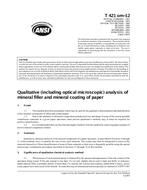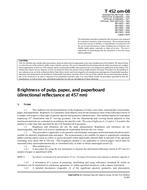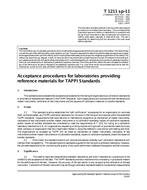Click here to purchase
Scope
1.1 This method describes procedures for obtaining a representative sample for testing. It should berecognized that in an ideal situation the samples selected should represent a lot of paper or paperboard, container board,or related product, including converted paper products (all hereafter referred to as “paper”). However, in some situationsthe sample may be as small as a single sheet of paper that has been provided to the laboratory for testing and may notrepresent the lot from which it is obtained.
1.1.1 Procedures are described (see Section 4) for establishing the lot of paper to be sampled.
1.1.2 The rules for selecting a representative sample for testing from this lot are described in Sections 5.1 and5.2. Specific sampling procedures are described (5.3) for large rolls or skids.
1.1.3 Specific procedures are described (5.4) for sampling from a single roll of containerboard for basis weightand burst strength.
1.1.4 A procedure is described (5.5) for the sampling and testing of a continuous strip of paper. In evaluatingthe performance of a process there may be advantages in measuring the cross or along machine variation in the product.An example could be the cross machine caliper profile to determine the processing variation caused by calendar rollloadings or crown. The evaluation of machine direction strips can provide information of performance of equipment, i.e.,a blocked couch roll.
1.1.5 A procedure is described (5.6) for handling a sample that may consist of a limited quantity of paper; or,may be as small as a single sheet of paper. Situations may arise where the testing laboratory has no control of the quantityof paper that is supplied for testing. An example could be the return of a piece of paper that the customer perceives to bedefective and the testing laboratory has been asked to quantify its properties. It must be recognized that in these situationsthe laboratory may not have control of the sampling procedure; and, the samples supplied and tested may not representthe lot of material from which they came.
1.2 Prior to purchase, there should be agreement between buyer and seller on the size of the lot to be sampled(3.1), on details of the sampling procedure, the required physical and chemical properties, dimensional tolerances, etc.,and the testing methods to be employed.
1.3 The appendices, which provide useful, statistical criteria for accepting individual lots of paper on thebasis of the number of defective test units, can assist the buyer and the seller in selecting an agreed upon sampling andacceptance procedure.
Product Details
- Published:
- 01/01/2011
- Number of Pages:
- 8
- File Size:
- 1 file , 65 KB


